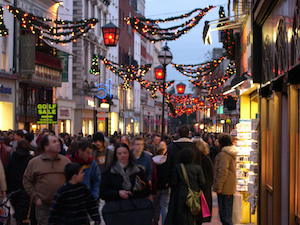 For many shopper marketers, this will be the first time they go into the festive season armed with some decent shopper data. For too long most shopper marketers had little data to go on, but as the recent survey conducted by Nielsen and engage suggests, the number of companies with shopper research in their hands is rising rapidly. These marketers could be forgiven for thinking that their shopper marketing efforts will be far more targeted, insightful and therefore effective this season, right? Unfortunately not; because the holiday shopper is quite unlike the shopper at any other time of the year.
For many shopper marketers, this will be the first time they go into the festive season armed with some decent shopper data. For too long most shopper marketers had little data to go on, but as the recent survey conducted by Nielsen and engage suggests, the number of companies with shopper research in their hands is rising rapidly. These marketers could be forgiven for thinking that their shopper marketing efforts will be far more targeted, insightful and therefore effective this season, right? Unfortunately not; because the holiday shopper is quite unlike the shopper at any other time of the year.
For most categories, the festive season which spans (depending on where you are in the world) from Thanksgiving to Chinese New Year is critically important. For some industries (confectionery, videos etc.) it can be enormously important. I worked in the toy industry extensively in the past and if we didn’t get Christmas and New Year right (both the western and Chinese varieties) we were in big trouble. And yet for most businesses they know least about the shopper at these times. Too often research is conducted at other times of the year: often because most retailers won’t let in-store research take place at that time of the year. But how different is the holiday shopper, and what can be done to at least begin to understand them?
It’s a different world
Before we start on the shopper’s state of mind, it’s important to recognize that even if the shopper was the same (which he isn’t) the world of shops changes dramatically. Retailers who at any other time of year would be reticent to change the store layout, or build huge displays, seem to have a change of heart and be willing to change pretty much anything in their stores. Everything looks different, such that even the most scrooge-minded shopper would struggle to behave as they usually would. Any data collected on what shoppers do the rest of the year, therefore needs to be looked at in this context: what were the stores like when the research was conducted, and what do the stores look like now.
More planning
Where we have data, it appears that when it comes to planning, holiday shoppers are much more likely to develop lists of what they want at Christmas than at any other time of year. These lists cover not just the present ideas (where lists may be as vague as “something for Uncle Ron” or “A Bottle of Talisker whisky for Uncle Pete”) but also when it comes to the grocery shop. Festive occasions are important, and often ritualized, so efforts are made to plan. Further, because shopping for the big day happens but once a year, shoppers aren’t in the habit of doing it, so are less confident in their ability to ‘wing it’ in the supermarket.
More impulse
Perversely, holiday shoppers will also buy on impulse. This may be that they add items over and above their plan, or that they are more than happy to substitute or change their plans in the store. Switching varies dramatically on how important a particular element is to the festive ritual (there are some brands my mom has bought ten years in a row and will never switch) and how well the alternative brand is known.
More bulk buying
I was looking at some data across a wide range of categories recently and noticed an interesting trend. Almost all of them showed an increase in transaction size in the weeks preceding the main festival. We’d expect an increase in carbonated beverages, snacks, etc. but the trend was apparent across personal care and household categories too. It wasn’t clear from the data whether this is caused by a general frivolity towards money – where shoppers are simply less budget conscious, or whether all of these categories become more important in the shopper’s mind at this time of year. Nobody wants to run out of dishwasher tablets or washing up liquid on Christmas afternoon, right, or have a light bulb fail over the dinner table and not have a replacement? Depending on your category, this might be an excellent time of year to encourage shoppers to stock up a little.
More expensive
Most shoppers are also happy to go a little bit wild at this time of the year and spend a little more. But before marketers of premium products go wild with their trial campaign, beware. Remember this is not the same shopper as the rest of the year, and the consumption occasion she is buying for isn’t the same. A trial induced at Christmas, no matter how effective or delicious it was, does not guarantee a repeat purchase in January when the (same) shopper is in a different looking store, in a different mindset, and buying for a very different consumption occasion.
The holiday shopper is a different shopper
The festive season is big and important for most of our shoppers, and therefore, as marketers it should be big and important for us. And whilst many marketers may have less data about the festive season shopper, if we remember that the holiday shopper is different: different mindset, different needs, different values (and of course, in a different store) and we choose carefully how we use this information to market to these shoppers effectively, there is no reason why the festive season can’t be extremely merry for your brand!
What are some of your past experiences with the holiday shopper? How are their behaviors different than the ordinary shopper? Share your stories and insights in the comments section below!

